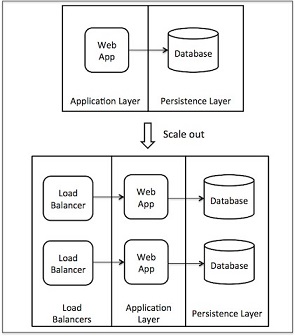CSC/ECE 517 Fall 2014/ch1a 20 rn
Scalability in Web Applications
This page starts with an introduction of scalability and its importance in web application. It then explains good programming practices and aspects to be considered to make a web application more scalable. In the end, there is a brief description on how to achieve scalability in Rails application
Introduction
Scalability is the ability of a system, network or process to handle an increase in load in a capable manner or its ability to expand to accommodate this increase. In a typical scenario, it can be understood as the ability of a system to perform extra work by the addition of resources (mostly hardware). It is generally difficult to define scalability precisely and in any particular case it is necessary to define the specific requirements for scalability on those dimensions that are deemed important. It is a highly significant issue in electronics systems, databases, routers, and networking. A system whose performance improves after adding hardware, proportionally to the capacity added, is said to be a scalable system. A very good example of a scalable system would be the Domain Name System. The distributed nature of the Domain Name System allows it to scale well even when new systems are added worldwide.
Scalability in Web Applications
Scalability of a web application is its ability to handle an increase in number of users or site traffic in a timely manner. Ideally, the experience in using the web application should be the same if the site has a single user or a million user. This kind of scalability is usually achieved with the addition of hardware in either a scaling up (vertical scaling) or a scaling out (horizontal scaling) manner. A typical web application follows a multilayered architecture. The web application is considered to be scalable if each layer or component in its architecture is scalable. Fig 1 shows a web application which is able to linearly scale out with the addition of resources in its application layer and database layer.<ref>http://highscalability.com/blog/2014/5/12/4-architecture-issues-when-scaling-web-applications-bottlene.html</ref>

Need for scalability in web applications
In this age ruled by the internet, web applications or web sites are essential for a company’s survival. Most applications are generally developed and tested with an initial small load. As the application gains popularity, the number of users ie traffic to the web site increases. The server which was able to handle the initial load might not be able to handle the new traffic. This causes the application to become unresponsive and result in a bad user experience which would affect the web site in an economic and/or defaming manner. It is thus important to design a web application with scalability in mind i.e. the application should be able to scale with the addition of new hardware without affecting the usability of the web application. Many popular web applications, especially social networking sites like Facebook and Twitter thrive because of their ability to scale for their ever increasing user base. For eg. Twitter has grown from 400,000 tweets posted per quarter in 2007<ref>http://www.telegraph.co.uk/technology/twitter/7297541/Twitter-users-send-50-million-tweets-per-day.html</ref> to 200,000,000+ monthly users and 500,000,000+ daily tweets in <ref>http://www.sec.gov/Archives/edgar/data/1418091/000119312513390321/d564001ds1.htm</ref>. However there are instances where even the most scalable architecture might not be able to handle the traffic. As an example, when American singer Michael Jackson died on June 25, 2009, Twitter servers crashed after users started updating their status at a rate of 100,000 tweets per hour <ref>http://news.bbc.co.uk/2/hi/technology/8120324.stm</ref>. Therefore, it is important for a web application to be highly scalable so that it is able to adjust to increase in traffic. Even if the web application is overwhelmed by a sudden spike, it should be able to quickly recover by the addition of more resources to ensure that there is minimum downtime, if not zero.
Scalability in Rails applications
Ruby on Rails(RoR), simply referred to as Rails, is a very elegant open source web application framework for creating the full stack by emphasizing on the use of well-known software engineering patterns and paradigms.<ref> http://guides.rubyonrails.org/getting_started.html#what-is-rails-questionmark</ref>. Many high-profile web firms use Ruby on Rails to build agile, scalable web applications. Some of the largest sites running Ruby on Rails include GitHub, Yammer, Scribd, Shopify, Hulu, and Basecamp<ref> http://articles.businessinsider.com/2011-05-11/tech/30035869_1_ruby-rails-custom-software</ref>. As of May 2014, it is estimated that more than 600,000 web sites are running Ruby on Rails.<ref><http://trends.builtwith.com/framework/Ruby-on-Rails></ref>
When Twitter had some significant downtimes in early 2008, a widespread myth started about Rails, ‘Rails doesn’t scale’<ref> http://techcrunch.com/2008/05/01/twitter-said-to-be-abandoning-ruby-on-rails></ref><ref>http://canrailsscale.com/></ref>. However, when Twitter’s lead architect, Blaine Cook held Ruby blameless<ref> http://highscalability.com/scaling-twitter-making-twitter-10000-percent-faster</ref>, the developer community came to the general conclusion that it is not the languages or frameworks that is a bottleneck to scaling, but the architecture. Therefore, Rails does scale well, but it is dependent on the condition that it has been architected to scale well.
Even though it applies to web applications in general, the following sections describe practices which help in the development of scalable Rails applications.
Optimizing Code for Scalability
Setting up Scalable Application Deployment
References
<references/>